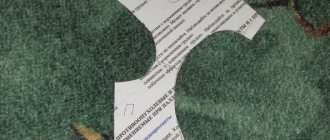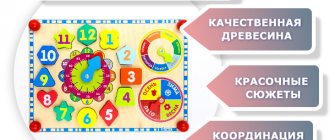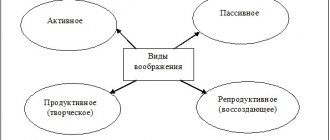Middle group
We present games on the theme “Dangerous Objects” for preschoolers of the middle age group.
Dangerous situations
For the lesson you need a sectorally divided circle, like the wheel in “Field of Miracles”. There should be 12 sectors, each with a corresponding number. The numbers should alternate in random order. On each sector you need to put a card depicting an emergency situation that a child may encounter at home, in kindergarten, in nature, or while walking.
Pupils take turns pulling out a card with a number from the bag. Find the corresponding sector. They look at the dropped plot picture, tell what is depicted, why this happened, and how to correct the situation.
Didactic game “Dangerous and safe objects”
The game is organized in the form of dominoes, and a group of 2 to 18 children participates. Players distribute cards. Using a counting rhyme or some other method, the player who starts the game is determined. He places any of the available cards. It shows an object on the right, and a picture on the left, symbolizing how a child should use this thing. There are three options:
- can be used under adult supervision;
- cannot be used - it is a dangerous thing;
- You can use it yourself - it’s a safe thing.
The player chooses how the depicted object can be used, gives reasons for the choice, and draws a conclusion whether the thing is dangerous or not dangerous. The player who was quicker than his comrades to determine which picture is needed puts down the card. The game continues until all the cards are placed correctly.
Why is a thing dangerous?
The game expands the understanding of how to behave correctly in everyday life, develops concentration, and fosters a spirit of mutual assistance. For the lesson, you need cards depicting various injuries: a cut, a hematoma, a fracture, a burn, a puncture. Images of household items are also needed.
Children sort out cards depicting injuries. The teacher takes turns showing pictures of things. Players must figure out what kind of injury can be caused by using the item shown. The player who has the corresponding image raises his hand, tells how dangerous the thing being demonstrated is, how to handle it correctly, then takes the card.
Role-playing games:
"We are firefighters"
Preliminary work:
- excursion to the fire station,
- conversations about the work of firefighters,
- looking at the pictures,
- reading stories about fire (L. Tolstoy “fire dogs”, S. Marshak “Cat’s House”, S. Mikhalkova “fire”),
- drawing on this topic,
- playing out situations about the rules of behavior in a fire,
- OOD on this topic.
Goal: to develop the ability to develop a plot based on knowledge of PPD; coordinate your actions with the actions of your partners, observe role interactions and relationships in the game. Coordinate and predict role-playing actions and behavior in accordance with the plot of the game.
Equipment: a set of fire trucks, helmets for firefighters, buckets, shovels, substitute items - cords, jump ropes, a Swedish ladder, a sports rope, sports mats, a set of toys “We are firefighters”, a tape recorder (audio recording of a “fire flasher”).
Game with the floor constructor “Fire in the city”.
Preliminary work:
- Construction of buildings,
- Games with floor constructor,
- Examination of the city street plan,
- Tour of the nearby neighborhood,
- Playing out situations on the theme “a fire truck on the city streets”,
- Conversations about the profession of firefighter,
- Guessing riddles
- Games with transport toys,
- Conversations about traffic rules on the topic of special vehicles on the street.
Goal: to consolidate the ability to take on various roles in accordance with the plot of the game; use attributes, constructor, building material, substitute objects. Promote the creative use of ideas about PPD in the game. Develop creative imagination, the ability to jointly unfold the yoke.
Equipment: different types of floor construction sets, diagram cards, toy fire trucks, small toys, audio recording of a fire flasher.
Didactic game “Make up a number”
Target:
consolidation of students’ knowledge about calling the Ministry of Emergency Situations in the event of a fire.
Children are divided into two groups and together, among the many numbers, they find the necessary ones and compose the telephone number of the Ministry of Emergency Situations - 101. The team that completes the task first wins.
IN.
Guys, now each of you knows which number to call if there is a fire. Let's repeat it all together again:
Children.
"Fire number: 101."
IN.
Remember that you can and should only call this number in case of a fire. When you hear the answer from the attendant, clearly state your name and address.
Didactic game-situation “Young firefighters rush to the rescue”
Target:
teaching children the basics of fire safety; development of logical thinking.
Progress of the game
Some children name an emergency, others name its possible consequences and actions that need to be taken. For example: “A burning paper fell on an easy chair... The chair would begin to smolder and catch fire. If no one is home, a big fire could happen and many apartments in this building would be damaged. In the event of a fire, you must quickly call the fire brigade by calling 101.”
Situational series:
- Burning paper flew into the open window of the apartment...
- Burning paper fell on dry grass near the house...
- Adults carelessly handle the fireplace...
- Boys playing with matches...
- A flame flared up in a frying pan on a burning stove...
- Unextinguished candles remained on the festive table...
Anna Marchenko
Security games
Didactic game “Evaluate the action”
Goal: To consolidate knowledge about the rules of using fire; cultivate a desire to comply with fire safety
.
Equipment: Subject pictures depicting situations:
1) actions of children or adults with objects that contribute to a fire;
2) actions of children or adults during fire extinguishing.
Progress of the game
Remember with your children how attentive a policeman who regulates traffic must be, because there are many cars driving along the street in different directions. Where are they going? Children will learn about this by receiving guide medallions depicting machines for various purposes.
The traffic policeman asks the drivers where they are going, what they are carrying and why they need to be let through faster. When the driver answers all the questions, focusing on his medallion, the policeman, together with the other children, decides whether he should be allowed through first.
Problem situations: Three cars met at an intersection. The policeman-regulator decides who needs to be let through first. Children discuss his decision, agree or object.
1. A bus with children, a truck with construction materials, an ice cream van.
2. Ambulance, car with bread, van with books.
3. Fire truck, milk tanker, van with furniture.
At the signal “The way is open”
the driver drives around the room. When all the drivers return, the medallions are taken apart by other children. They come up with new problem situations.
Didactic game “Ecological traffic light”
Goal: To consolidate children's knowledge of observing safety rules in the natural environment
. Develop logical thinking, memory, imagination, and the ability to admire the beauty of the world around us. Foster a caring attitude towards nature.
Material: Pictures depicting various situations of behavior in nature, green and red chips.






